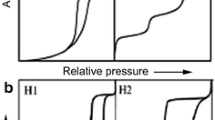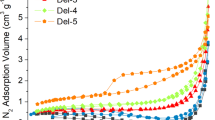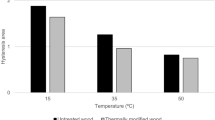Abstract
The cell-wall micropore network of oven-dried Corsican and Scots pine sapwood has been investigated by reaction with acetic and propionic anhydride in a non-swelling solvent (xylene). No significant reaction occurred, except in the case of reaction between Corsican pine and acetic anhydride. However, when the wood samples were in a swollen state, reaction occurred between the wood and both anhydrides. It is concluded that the cell-wall micropores of Corsican pine are sufficiently large to allow access of acetic anhydride, but not propionic into the unswollen cell wall; however, with Scots pine, both reagents are too large to gain access. A further series of experiments was performed whereby the volumetric changes of pine sapwood samples due to modification with a range of linear chain anhydrides were determined. With Corsican pine, larger volume changes than theoretically predicted were observed, whereas, with the Scots pine samples, the volume changes were close to those predicted. When account is taken of the volume that the reagent occupies within the cell wall, it was found that larger void volumes occurred in the Corsican pine samples. This result indicates that the cell-wall polymeric environment surrounding a reagent molecule is more compliant in the case of Corsican pine.











Similar content being viewed by others
References
Dawson BSW, Franlich RA, Kroese HW, Steward D (1999) Reactivity of radiata pine sapwood towards carboxylic acid anhydrides. Holzforschung 53:195–198
Flournoy DS, Paul JA, Kirk TK (1991) Wood decay by brown rot fungi. Changes in pore structure and cell wall pore volume. Holzforschung 45:383–388
Flournoy DS, Paul JA, Kirk TJ, Highley TL (1993) Changes in the size and volume of pores in sweetgum wood during simultaneous rot by Phanerochaete chrysosoprium Burds. Holzforschung 47:297–301
Hermans PH (1946) Contributions to the physics of cellulose fibers. Elsevier, Amsterdam
Hill CAS, Hillier J (1999) Studies of the reaction of carboxylic acid anhydrides with wood. Experimental determination and modelling of kinetic profiles. Phys Chem Phys 1:1569–1576
Hill CAS, Jones D (1996a) A chemical kinetics study of the propionic anhydride modification of Corsican pine. I. Determination of activation energies. J Wood Chem Technol 16:235–247
Hill CAS, Jones D (1996b) The dimensional stabilisation of Corsican pine sapwood by reaction with carboxylic acid anhydrides. The effect of chain length. Holzforschung 50:457–462
Hill CAS, Jones D (1999) Dimensional changes in Corsican pine sapwood due to chemical modification with linear chain anhydrides. Holzforschung 53:267–271
Hill CAS, Abdul Khalil HPS, Hale MD (1998) A study of the potential of acetylation to improve the properties of plant fibres. Ind Crops Prod 8:53–63
Hill CAS, Cetin NS, Ozmen N (2000) Potential catalysts for the acetylation of wood. Holzforschung 53:269–272
Kellogg RM, Wangaard FF (1969) Variation in the cell wall density of wood. Wood Fiber 1:180–204
Krassig H (1985) Structure of cellulose and its relation to properties of cellulose fibers. In: Kennedy JF, Phillips GO, Wedlock DJ, Williams PA (eds) Cellulose and its derivatives. Ellis Horwood, Chichester, pp 3–25
Li J-Z, Furuno T, Katoh S, Uehara T (2000) Chemical modification of wood by anhydrides without solvents or catalysts. J Wood Sci 46:215–221
Morisato K, Kotani H, Ishimura Y, Urakami H (1999) Adsorption of liquids and swelling of wood. IV. Temperature dependence on the adsorption. Holzforschung 53:669–674
Nakano T (1994) Mechanism of thermoplasticity for chemically modified wood. Holzforschung 48:318–324
Patscheke G, Dilg K (1958) Untersuchungen uber herstekkung und reaktionsfahigkeit von inklusionsholzern. Archiv Forstwesen 7:203–219
Ramsden MJ, Blake FSR, Fey NJ (1997) The effect of acetylation on the mechanical properties, hydrophobicity, and dimensional stability of Pinus sylvestris. Wood Sci Technol 31:97–104
Robertson AA (1970) Interactions of liquids with cellulose. Tappi 53:1331–1339
Rowell RM (1983) Chemical modification of wood. For Prod Abstr 6:363–382
Rowell RM, Ellis WD (1978) Determination of the dimensional stabilisation of wood by the water soak method. Wood Fiber 10:104–111
Sawabe O, Mori K, Takeuchi T (1973) Micro-pore structure in cell wall of wood. Mokuzai Gakkaishi 19:55–62
Siau JF (1984) Transport processes in wood. Springer, Berlin Heidelberg New York
Slonimskii GL, Askadskii AA, Kitaigorodskii KM (1970) About packing of macromolecules in polymers. Vysokomol Soedin A12:494–512
Stamm AJ (1964) Wood and cellulose science. Ronald Press, New York
Stamm AJ, Hansen LA (1935) Minimising wood shrinkage and swelling. Replacing water in wood with non-volatile materials. Ind Eng Chem 27:1480–1484
Stone JE (1964) The porous structure of wood and fibres. Pulp Paper Mag Can 65:T3–T12
Stone JE, Scallan AM (1965a) The effect of component removal upon the porous structure of the cell wall of wood. J Polym Sci Part C 11:13–23
Stone JE, Scallan AM (1965b) A study of cell wall structure by nitrogen adsorption. Pulp Paper Mag Can 66:T407–T414
Stone JE, Scallan AM (1967) The effect of component removal upon the porous structure of the cell wall of wood. II. Swelling in water and the fiber saturation point. Tappi 50:496–501
Stone JE, Scallan AM (1968a) The effect of component removal upon the porous structure of the cell wall of wood. Part III A comparison between the sulphite and kraft process. Pulp Paper Mag Can 69:69–72
Stone JE, Scallan AM (1968b) A structural model for the cell wall of water swollen wood pulp fibers based on their accessibility to macromolecules. Cellulose Chem Technol 2:343–358
Stone JE, Scallan AM, Aberson GMA (1966) The wall density of native cellulose fibers. Pulp Paper Mag Can 67:T263–T268
Stone JE, Scallan AM, Abrahamson B (1968) Influence of beating on cell wall swelling and internal fibrillation. Svensk Papperstidn 7:687–694
Tarkow H, Feist WC, Southerland CF (1966) Interaction of wood with polymeric materials: penetration versus molecular size. For Prod J 16:61–65
Weatherwax RC (1977) Collapse of cell wall pores during drying of cellulose. J Colloid Interface Sci 62:432–446
Weatherwax RC, Caulfield DF (1971) Cellulose aerogels. An improved method for preparing a highly expanded form of dry cellulose. Tappi 54:985–986
West H (1988) Kinetics and mechanism of wood isocyanate reactions. PhD Thesis, University of Wales, Bangor
Wilfong JC (1966) Specific gravity of wood substance. For Prod J 16:55–61
Author information
Authors and Affiliations
Corresponding author
Rights and permissions
About this article
Cite this article
Hill, C.A.S., Papadopoulos, A.N. & Payne, D. Chemical modification employed as a means of probing the cell-wall micropore of pine sapwood. Wood Sci Technol 37, 475–488 (2004). https://doi.org/10.1007/s00226-003-0193-5
Received:
Published:
Issue Date:
DOI: https://doi.org/10.1007/s00226-003-0193-5




